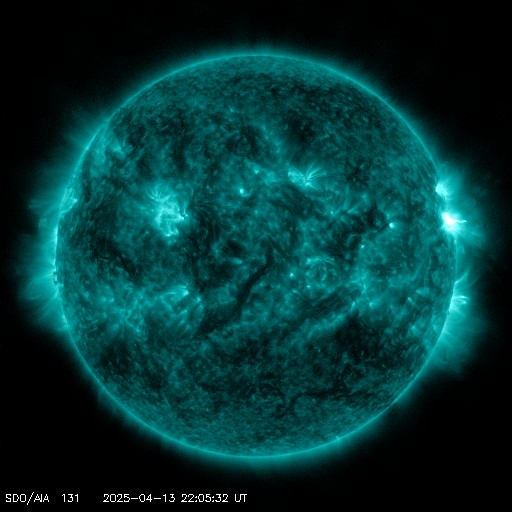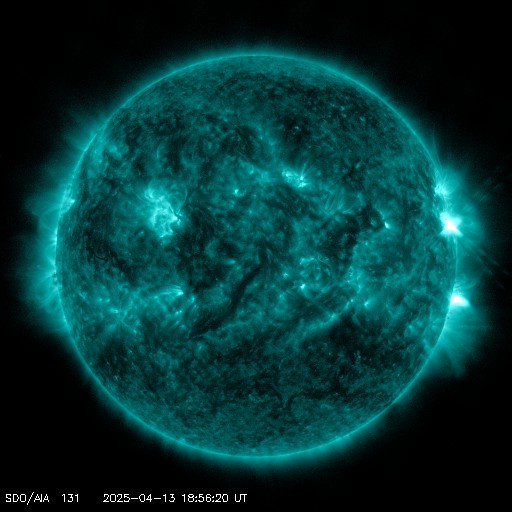Viewing archive of Sunday, 24 September 2017
Daily bulletin on solar and geomagnetic activity from the SIDC
Issued: 2017 Sep 24 1230 UTC
SIDC Forecast
Solar flares
C-class flares expected, (probability >=50%)
Geomagnetism
Active conditions expected (A>=20 or K=4)
Solar protons
Quiet
| 10cm flux | Ap | |
|---|---|---|
| 24 Sep 2017 | 084 | 009 |
| 25 Sep 2017 | 087 | 016 |
| 26 Sep 2017 | 090 | 007 |
Bulletin
Over the past 24 hours the solar activity was very low. Only small B-class flares and one non-Earth directed slow-speed CME were recorded. Catania sunspot groups 56 (NOAA active regions 2681) has increased its magnetic complexity (from Alpha to Beta class), but has not shown any flaring activity. The returning region NOAA active region 2682 (previously, Catania sunspot group 46, NOAA active region 2673) is now on the visible disc and is the source of the slow-speed CME and B-class flaring activity. Its magnetic complexity is difficult to estimate due to the projection effect, however, it seems to have drastically decay from the previous solar rotation. We expect the solar activity to increase due to the return of this region with C-class flares.
No Earth directed CMEs have been observed and the solar protons remained at background level over the past 24 hours. The Earth remained inside a slow solar wind flow. The speed has further decreased from about 400 to 330 Km/s. The interplanetary magnetic field magnitude remained below 6 nT and the Bz component fluctuated between -5 and 5 nT. The associated fast solar wind to the small equatorial coronal hole that has crossed the central meridian on Sept 20 has not arrived yet and is expected to arrive at Earth today. A new larger coronal hole with positive polarity is currently facing Earth. This coronal hole is elongated from the north solar pole to the solar Equator and its high speed stream is expected to arrive at Earth in about 3 days from now (on Sept 27).
Geomagnetic conditions were quiet with Kp (NOAA) and local K (Dourbes) indexes ranging between 1-2. The geomagnetic conditions are expected to become more active with the arrival of the high speed stream from the coronal hole that has crossed the central meridian on Sept 20. As this coronal hole was relatively small, no strong or sever magnetic storm is expected.
Today's estimated international sunspot number (ISN): 023, based on 18 stations.Solar indices for 23 Sep 2017
| Wolf number Catania | /// |
| 10cm solar flux | 081 |
| AK Chambon La Forêt | 009 |
| AK Wingst | 007 |
| Estimated Ap | 005 |
| Estimated international sunspot number | 013 - Based on 27 stations |
Noticeable events summary
| Day | Begin | Max | End | Loc | Strength | OP | 10cm | Catania/NOAA | Radio burst types | |
|---|---|---|---|---|---|---|---|---|---|---|
| None | ||||||||||
Provided by the Solar Influences Data analysis Center© - SIDC - Processed by SpaceWeatherLive
All times in UTC
Current data suggests there is a slight possibility for aurora to appear at the following high latitude regions in the near future
Gillam, MB, Iqaluit, NU, Yellowknife, NTLatest news
Latest forum messages
Support SpaceWeatherLive.com!
A lot of people come to SpaceWeatherLive to follow the Sun's activity or if there is aurora to be seen, but with more traffic comes higher server costs. Consider a donation if you enjoy SpaceWeatherLive so we can keep the website online!

Latest alerts
04:45 UTC - Geomagnetic activity
Active geomagnetic conditions (Kp4) Threshold Reached: 04:29 UTC
Sunday, 13 April 2025
22:21 UTC - Solar flare
Moderate M1.66 flare from sunspot region 4055
22:03 UTC - Radio Blackout
Minor R1 radio blackout in progress (≥M1 - current: M1.01)
20:48 UTC - Hemispheric Power Index
The OVATION model predicts the Hemispheric Power Index to reach 50GW at 21:39 UTC
19:09 UTC - Solar flare
Moderate M3.24 flare from sunspot region 4055
Space weather facts
| Last X-flare | 2025/03/28 | X1.1 |
| Last M-flare | 2025/04/13 | M1.6 |
| Last geomagnetic storm | 2025/04/06 | Kp5 (G1) |
| Spotless days | |
|---|---|
| Last spotless day | 2022/06/08 |
| Monthly mean Sunspot Number | |
|---|---|
| March 2025 | 134.2 -20.4 |
| April 2025 | 132.1 -2.1 |
| Last 30 days | 132.4 -10.7 |





